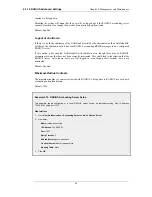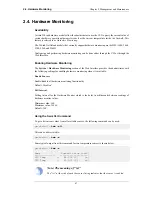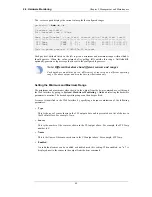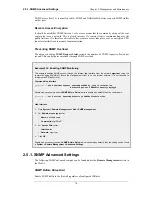
Chapter 3. Fundamentals
This chapter describes the fundamental logical objects which make up a NetDefendOS
configuration. These objects include such items as IP addresses and IP rules. Some exist by default
and some must be defined by the administrator.
In addition, the chapter explains the different interface types and explains how security policies are
constructed the administrator.
• The Address Book, page 80
• Services, page 85
• Interfaces, page 93
• ARP, page 112
• IP Rule Sets, page 121
• Schedules, page 131
• Certificates, page 133
• Date and Time, page 137
• DNS, page 144
3.1. The Address Book
3.1.1. Overview
The NetDefendOS Address Book contains named objects representing various types of IP addresses,
including single IP addresses, networks as well as ranges of IP addresses.
Using address book objects has a number of important benefits:
•
It increases understanding of the configuration by using meaningful symbolic names.
•
Using address object names instead of entering numerical addresses reduces errors.
•
By defining an IP address object just once in the address book and then referencing this
definition, changing the definition automatically also changes all references to it.
3.1.2. IP Addresses
IP Address objects are used to define symbolic names for various types of IP addresses. Depending
on how the address is specified, an IP Address object can represent either a single IP address (a
specific host), a network or a range of IP addresses.
In addition, IP Address objects can be used for specifying the credentials used in user
authentication. For more information about this topic, see Chapter 8, User Authentication.
The following list presents the various types of addresses an IP Address object can hold, along with
what format that is used to represent that specific type:
Host
A single host is represented simply by its IP address.
For example, 192.168.0.14.
80
Summary of Contents for DFL-1600 - Security Appliance
Page 27: ...1 3 NetDefendOS State Engine Packet Flow Chapter 1 NetDefendOS Overview 27 ...
Page 79: ...2 7 3 Restore to Factory Defaults Chapter 2 Management and Maintenance 79 ...
Page 146: ...3 9 DNS Chapter 3 Fundamentals 146 ...
Page 227: ...4 7 5 Advanced Settings for Transparent Mode Chapter 4 Routing 227 ...
Page 241: ...5 4 IP Pools Chapter 5 DHCP Services 241 ...
Page 339: ...6 7 Blacklisting Hosts and Networks Chapter 6 Security Mechanisms 339 ...
Page 360: ...7 4 7 SAT and FwdFast Rules Chapter 7 Address Translation 360 ...
Page 382: ...8 3 Customizing HTML Pages Chapter 8 User Authentication 382 ...
Page 386: ... The TLS ALG 9 1 5 The TLS Alternative for VPN Chapter 9 VPN 386 ...
Page 439: ...Figure 9 3 PPTP Client Usage 9 5 4 PPTP L2TP Clients Chapter 9 VPN 439 ...
Page 450: ...9 7 6 Specific Symptoms Chapter 9 VPN 450 ...
Page 488: ...10 4 6 Setting Up SLB_SAT Rules Chapter 10 Traffic Management 488 ...
Page 503: ...11 6 HA Advanced Settings Chapter 11 High Availability 503 ...
Page 510: ...12 3 5 Limitations Chapter 12 ZoneDefense 510 ...
Page 533: ...13 9 Miscellaneous Settings Chapter 13 Advanced Settings 533 ...





































